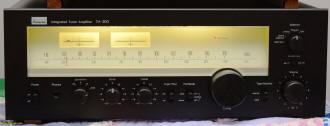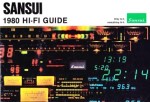|
<Previous
Next>
 Sometime around 1981, while stationed at
Robins AFB, Georgia, I finally succumbed to the peer pressure of other more sophisticated
audiophiles in the barracks and bought a "real" stereo. Unlike my roommate who had
a full compliment of rack-mounted gear, my meager enlisted military pay only allowed
for a mid-grade instrument. The solution was a
Sansui
TA-300 Integrated Tuner Amplifier. It put out a whopping 30 watts per channel, but
unlike my existing radio (a
Readers Digest 800-XR), those 30 watts were nearly distortion
free when driving good speakers. Having only the pathetic 5 W speakers that
came with the 800-XR, I designed a set of speakers rated for 60 W, and built
the enclosures myself in the base woodshop. Unfortunately, in preparation for a
household move about 20 years ago, I sold the Sansui and the speakers. Sometime around 1981, while stationed at
Robins AFB, Georgia, I finally succumbed to the peer pressure of other more sophisticated
audiophiles in the barracks and bought a "real" stereo. Unlike my roommate who had
a full compliment of rack-mounted gear, my meager enlisted military pay only allowed
for a mid-grade instrument. The solution was a
Sansui
TA-300 Integrated Tuner Amplifier. It put out a whopping 30 watts per channel, but
unlike my existing radio (a
Readers Digest 800-XR), those 30 watts were nearly distortion
free when driving good speakers. Having only the pathetic 5 W speakers that
came with the 800-XR, I designed a set of speakers rated for 60 W, and built
the enclosures myself in the base woodshop. Unfortunately, in preparation for a
household move about 20 years ago, I sold the Sansui and the speakers.

Sansui TA-300 Integrated Tuner Amplifier rear panel.

±24 V power supply series resistors measured open.

56 Ω, ¼ W series resistors (R40 and R42). I didn't
have any 56 Ω resistors, so I paralleled a 150 Ω and a 100 Ω.
 On
a whim, I checked eBay to see whether anyone was selling a TA-300, and for
a long time none were available. When one finally appeared (thanks to the Saved
Search feature), the price was north of $200 with shipping (it's pretty heavy) was
nearly $80. That is outside my nostalgia budget, so I waited for two or three years
until finally this one showed up for a mere $120 with $32 shipping. It is in near
mint physical condition, but the guy selling it said the phono input was not functional.
He included a third-party phonograph preamp (Pyle PP444) for use in feeding it in through the Aux input. I
figured a highly experienced electronics guy like myownself (sic) should be able
to get the Phono input working again. I took a chance and ordered it, and am very
pleased with the unit. On
a whim, I checked eBay to see whether anyone was selling a TA-300, and for
a long time none were available. When one finally appeared (thanks to the Saved
Search feature), the price was north of $200 with shipping (it's pretty heavy) was
nearly $80. That is outside my nostalgia budget, so I waited for two or three years
until finally this one showed up for a mere $120 with $32 shipping. It is in near
mint physical condition, but the guy selling it said the phono input was not functional.
He included a third-party phonograph preamp (Pyle PP444) for use in feeding it in through the Aux input. I
figured a highly experienced electronics guy like myownself (sic) should be able
to get the Phono input working again. I took a chance and ordered it, and am very
pleased with the unit.
Upon receipt (he did an excellent packing job), I removed the cover and blew
out the chassis with compressed air (very little dust) and wiped down the inside
and outside of the chassis. It was very clean all over with only minor visible wear.
Next, I set the chassis up on my workbench and patched in some test speakers and
a 1 kHz sinewave for use with the various external inputs. The "A" and "B"
speaker outputs checked out for both Left and Right channels using the FM and AM
radio tuner. Then the test signal was fed into the Aux and Tape jacks to verify
operation. Last, saving the known problem for last (good news first), I moved on
to the Phono input and discovered that the Left channel functioned properly, but
the Right channel was dead.
At that time, I had not yet found a free, downloadable
Sansui TA-300
User's Manual, so I began probing with the oscilloscope to see how far into
the circuit the external signal got. It went to the base of the first transistor,
with no signal on the collector or emitter. Since the Left channel was working,
I compared the signals to it and found that the DC power rails were way off. Accordingly,
I started checking the DC power input. To my surprise, I discovered that both of
the 56 Ω, ¼ W series resistors (R40 and R42*) measured as
open circuits. Neither of them appeared to be overheated, nor a burnt odor, nor
were brittle or broke when removed, at least one of which symptoms typically are
present when a resistor "blows." The capacitors and other components in the region
measured good, as did the transistors. I took a chance and soldered in replacement
resistors and fired it up. Everything worked perfectly (and is still working a day
later). I am completely perplexed as to how those two resistors could have gone
bad, but I'm equally thrilled that replacing them did the job!
* The schematic for the F-3015 Equalizer
Amp Circuit Board shows a different value as used for the 50 W (TA-500) model,
but a note on the page affirms the 56 Ω values.
|

Sansui TA-300 top front interior view.

Sansui TA-300 top right interior view.

Sansui TA-300 top left interior view.

Sansui TA-300 top rear interior view.


Sansui TA-300 Integrated Tuner Amplifier Service Manual

Sansui TA-300 Integrated Tuner Amplifier as it appears in the
Sansui 1980 HiFi Guide
pamphlet.
|

Sansui TA-300 bottom interior view.

Sansui TA-300 bottom front interior view.

Sansui TA-300, F-3016 Tone Control & Power Amp Board.

Sansui TA-300, F-2983 Selector Circuit Board

Sansui TA-300 F-3015 Equalizer Amp Circuit Board
Component Layout

Sansui TA-300, F-3015 Equalizer Amp Circuit Board Schematic
|
Posted May 20, 2019
|


























 "
"

















